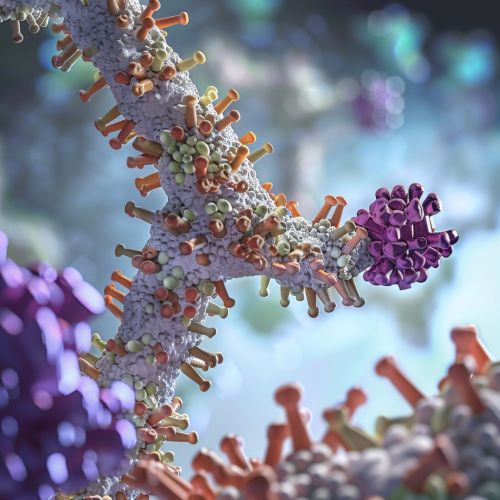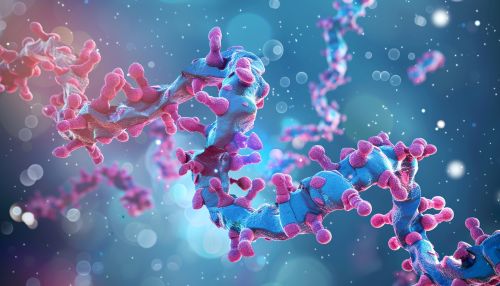Protein Kinase A: Difference between revisions
(Created page with "== Overview == '''Protein Kinase A''' (PKA), also known as cAMP-dependent protein kinase, is an enzyme that plays a pivotal role in the regulation of various cellular processes. It is a member of the protein kinase family and is activated by the molecule cyclic adenosine monophosphate (cAMP). PKA is involved in the regulation of glycogen, sugar, and lipid metabolism, and it is crucial for the modulation of various cellular functions such as gene expression, cell growth,...") |
No edit summary |
||
| Line 15: | Line 15: | ||
The catalytic subunits of PKA are responsible for the phosphorylation of target proteins. There are three isoforms of the catalytic subunits: Cα, Cβ, and Cγ. These isoforms also differ in their tissue distribution and substrate specificity. | The catalytic subunits of PKA are responsible for the phosphorylation of target proteins. There are three isoforms of the catalytic subunits: Cα, Cβ, and Cγ. These isoforms also differ in their tissue distribution and substrate specificity. | ||
[[Image:Detail-92837.jpg|thumb|center|Illustration of Protein Kinase A structure showing regulatory and catalytic subunits.|class=only_on_mobile]] | |||
[[Image:Detail-92838.jpg|thumb|center|Illustration of Protein Kinase A structure showing regulatory and catalytic subunits.|class=only_on_desktop]] | |||
== Activation Mechanism == | == Activation Mechanism == | ||
Latest revision as of 16:55, 21 June 2024
Overview
Protein Kinase A (PKA), also known as cAMP-dependent protein kinase, is an enzyme that plays a pivotal role in the regulation of various cellular processes. It is a member of the protein kinase family and is activated by the molecule cyclic adenosine monophosphate (cAMP). PKA is involved in the regulation of glycogen, sugar, and lipid metabolism, and it is crucial for the modulation of various cellular functions such as gene expression, cell growth, and apoptosis.
Structure
PKA is a holoenzyme composed of two regulatory (R) subunits and two catalytic (C) subunits. In its inactive form, the regulatory subunits bind to the catalytic subunits, inhibiting their activity. Upon binding of cAMP to the regulatory subunits, a conformational change occurs, leading to the dissociation of the catalytic subunits, which then become active.
Regulatory Subunits
The regulatory subunits of PKA are responsible for binding cAMP and regulating the activity of the catalytic subunits. There are four isoforms of the regulatory subunits: RIα, RIβ, RIIα, and RIIβ. These isoforms differ in their tissue distribution and regulatory properties.
Catalytic Subunits
The catalytic subunits of PKA are responsible for the phosphorylation of target proteins. There are three isoforms of the catalytic subunits: Cα, Cβ, and Cγ. These isoforms also differ in their tissue distribution and substrate specificity.


Activation Mechanism
The activation of PKA is initiated by the binding of cAMP to the regulatory subunits. This binding induces a conformational change that releases the catalytic subunits from the regulatory subunits. The free catalytic subunits are then able to phosphorylate target proteins on serine and threonine residues.
Role of cAMP
cAMP is a second messenger that is synthesized from ATP by the enzyme adenylate cyclase. The production of cAMP is regulated by various extracellular signals, including hormones and neurotransmitters. The binding of cAMP to the regulatory subunits of PKA is a crucial step in the activation of the enzyme.
Functions
PKA is involved in a wide range of cellular processes, including:
Metabolic Regulation
PKA plays a critical role in the regulation of glycogen, sugar, and lipid metabolism. It phosphorylates key enzymes involved in these metabolic pathways, thereby modulating their activity. For example, PKA phosphorylates and activates glycogen phosphorylase, which is involved in glycogen breakdown.
Gene Expression
PKA regulates gene expression by phosphorylating transcription factors such as cAMP response element-binding protein (CREB). Phosphorylated CREB binds to specific DNA sequences called cAMP response elements (CRE), leading to the transcription of target genes.
Cell Growth and Apoptosis
PKA is involved in the regulation of cell growth and apoptosis. It phosphorylates and modulates the activity of various proteins involved in these processes, including Bcl-2 and BAD. PKA-mediated phosphorylation of these proteins can either promote or inhibit apoptosis, depending on the cellular context.
Clinical Significance
Dysregulation of PKA activity has been implicated in various diseases, including cancer, cardiovascular diseases, and neurological disorders.
Cancer
Aberrant PKA signaling has been associated with the development and progression of various cancers. For example, mutations in the regulatory subunits of PKA have been identified in patients with Carney complex, a genetic disorder that predisposes individuals to multiple neoplasms.
Cardiovascular Diseases
PKA plays a crucial role in the regulation of cardiac function. Dysregulation of PKA activity has been linked to various cardiovascular diseases, including heart failure and arrhythmias. PKA-mediated phosphorylation of proteins involved in cardiac contractility and calcium handling is essential for normal heart function.
Neurological Disorders
PKA is involved in various neurological processes, including learning and memory. Dysregulation of PKA signaling has been implicated in neurological disorders such as Alzheimer's disease and Parkinson's disease. PKA-mediated phosphorylation of proteins involved in synaptic plasticity is crucial for normal cognitive function.
Research and Therapeutic Implications
Given its central role in various cellular processes, PKA is a target of interest for therapeutic interventions. Research is ongoing to develop specific inhibitors and activators of PKA for the treatment of various diseases.
Inhibitors
Specific inhibitors of PKA, such as H-89 and KT5720, have been developed and are widely used in research to study the role of PKA in various cellular processes. These inhibitors are also being investigated for their potential therapeutic applications in diseases characterized by aberrant PKA activity.
Activators
Activators of PKA, such as forskolin, are used to increase cAMP levels and activate PKA. These activators are being explored for their potential therapeutic applications in diseases where enhanced PKA activity may be beneficial.
See Also
- Adenylate Cyclase
- CREB
- Glycogen Phosphorylase
- Bcl-2
- Bad
- Carney Complex
- Alzheimer's Disease
- Parkinson's Disease
